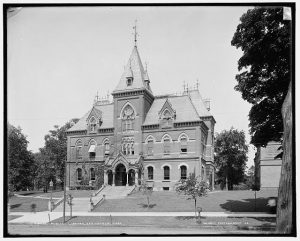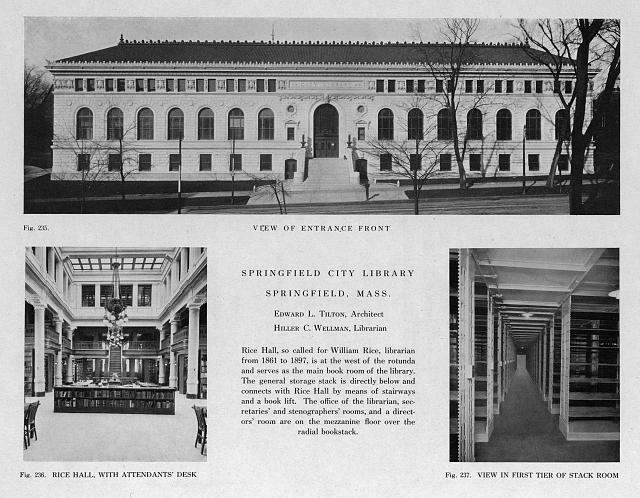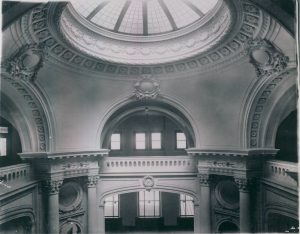Springfield Library Company was begun prior to 1796, and a printed catalog issued on that date shows 320 volumes.

Yet this and other libraries like it were not public libraries, but were limited to specific groups of people. The first general law authorizing Massachusetts cities and towns to maintain public libraries was enacted in 1851, and in 1855 Springfield residents signed a petition asking for funding for a library. Due to the cost of the new city hall, funds were not available. In 1857 the City Library Association was formed, and although still privately funded, a room in City Hall was provided for use as a library.
By 1863 private donations and gifts totaled $77,000. After raising $100,000, a red-brick Gothic style building was erected at the corner of State and Chestnut Streets on land donated by George Bliss. In 1885 a city appropriation made it possible for the Library to be free to all.
By 1892 the Library had outgrown the building, and the city appropriated $18,498 for a new library building. A very unusual twist is that in order to be able to provide library service to the community during construction of a new building, Charles R. Trask, one of its original builders, was hired to move the entire library back 200 feet to make room for the new building! Newspapers and magazines were moved to a nearby building, a temporary wooden structure was built to use as the Children’s Room for the next two years, and the Christ Church Rectory was moved to the other side of the church. After knocking out the library basement, 12 long steel slides were put under the building to support the walls, which were resting on huge timbers. According to the 1909 Annual Library Report, “each cardholder was allowed to borrow six works of fiction and any reasonable number of other books.” Before the actual move over 15,000 books were borrowed just the last five days alone! It was estimated that the building contents weighed three to four thousand tons. Using 1,000 small steel rollers, twelve men working in unison operated turn screws to move the building an average of ten feet per day. In less than three weeks they had moved the building almost 200 feet, and were open for business while construction continued on the new library. In 1905 Andrew Carnegie donated $260,000 to the City Library Association to build a central library and three branch libraries.

In its 1909 annual report, the City Library Association stated, “the crowning event of the year is the beginning of work on the new building for the main library.” Work began on April 1st, and completion was predicted for the summer of 1910 at a cost of $240,000. With the Carnegie funds and $155,000 in contributions from Springfield citizens, an Italian Renaissance Revival style building was planned. “Public-spiritedness is so evident in the residents of Springfield” that Carnegie twice increased his donations. The new library on State Street was built of reinforced concrete with a pink granite base, surrounded by white Vermont marble, with a frieze of white terra cotta, and topped with a dark green tile roof. When it was time to move the books into the new building, City Librarian Hiller C. Wellman came up with an innovative plan. A trestle was built between the second floor of the old library to the main floor of the new one, a distance of 125 feet. An inclined gravity cable car system was devised, using two 6 foot by 2 foot boxes and with staff located at both ends, books moved quickly from the old to the new building. Books were immediately placed on the proper shelves, and the only books that could not be borrowed were those that were in transit! The move was completed in only eight working days.

On January 10, 1912 the current building was opened to the public. The second floor Rotunda has been called “the Library’s grand center court” with its Corinthian columns, balustrade, elaborate architectural details and amber-tinted glass dome. The head of the ancient goddess of wisdom Minerva adorns four shields beneath the dome, and a bronze bust of Andrew Carnegie can be found in the Rotunda. A frieze of horses and riders inspired by bas-relief ornamentation of the Parthenon enhances the entry leading to the Rotunda from State Street.
In 1974 the Central Library was placed on the National Register of Historic Places.
In 1998 the Rotunda was restored to its original elegance with a matching grant from the Massachusetts Historical Commission. The building is on the State Historic Register and is part of the Quadrangle- Mattoon Historic District in the City of Springfield.
City Librarians quoted:
Reverend William Rice, born in Springfield in 1821, was the “master hand” behind the Springfield City Library from 1861-1897, with complete charge of the selection and classification of the books. For some time the previous library building was known as the William Rice Building, to honor the man who “filled it with treasures of knowledge and wisdom for the free use of all the people.”
Hiller C. Wellman began his tenure as City Librarian in 1902 at the age of 31. He was instrumental in the planning of this building, one of the first libraries to feature open shelving, and said to be the first to circulate phonograph records. Mr. Wellman retired in 1948, and died in 1956.
